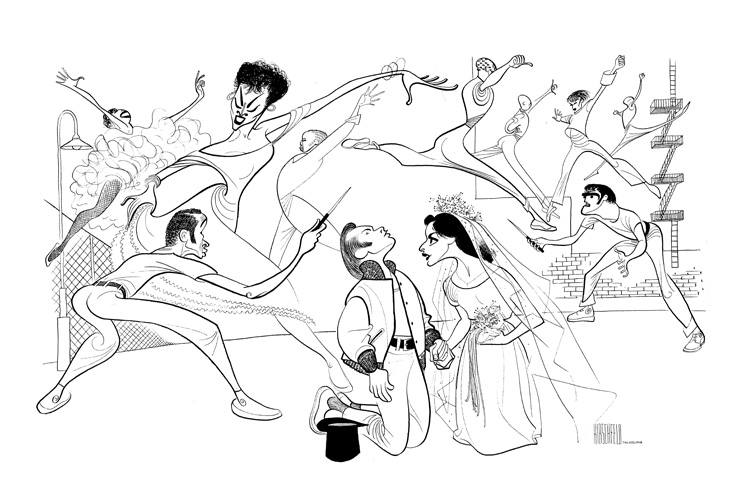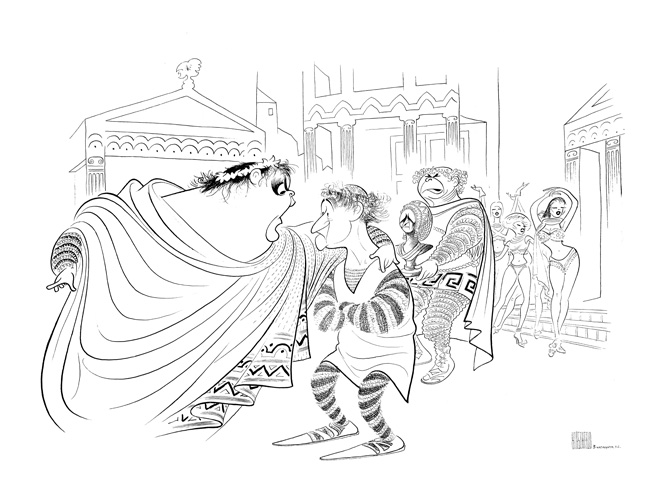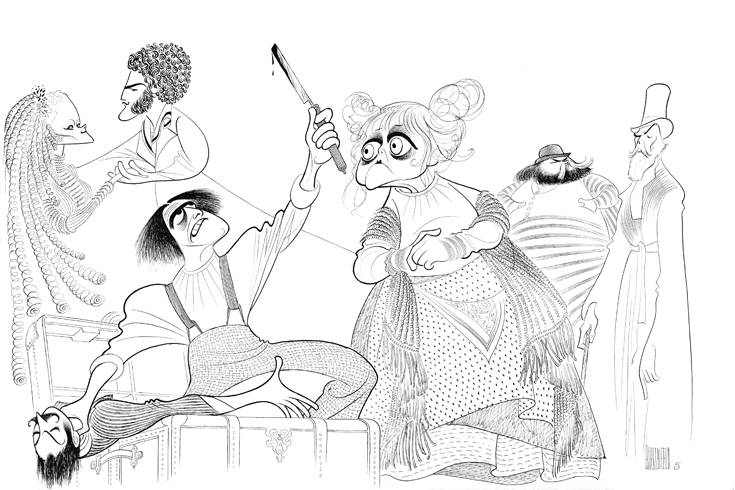Review by Alix Cohen
With this 11” x 17” book, you too can put a Hirschfeld on your wall or gift an uber-fan. There are 58 pages, 50 drawings and 25 glossy, thick, ready to frame posters.
Al Hirschfeld’s drawings first appeared in newspapers in 1921. His first published caricature arrived 5 years later. The first theatrical caricature, a year after that. In 1957, the artist drew West Side Story, his first Sondheim for the arts section cover of The New York Times. (in 1980 he would draw the revival.) Fifty years of capturing the essence of memorable Stephen Sondheim musicals (live and in film) followed.

West Side Story
“Steve and Al both dealt with lines and dots,” writes Bernadette Peters in the introduction. “Al’s turned into a lively picture of people singing, dancing and acting…Steve’s dots and lines and squiggles create musical phrases that would turn into a song…”
Ben Brantley (The New York Times) who has attended and written about decades of Sondheim’s work finds that “…visuals that come closest to evoking it are not photos or videos of performance, but instead black lines-and whorls and swirls and loops-on white paper…” (The foreword)
Each full page illustration is accompanied by background information on the play: its chronology, creators, plot, nominations/awards, fate; sometimes the specific scene depicted or a particularly memorable performer. Why did the artist choose what he did to depict? Why do some moments include scenery or chorus members while others do not? (There are smaller drawings as well.)
“My contribution is to take the character – created by the playwright and acted out by the actor- and reinvent it for the reader.” (Hirschfeld)

A Funny Thing Happened on the Way to the Forum
There’s allusion to the relationship between Sondheim and surrogate father/mentor Oscar Hammerstein II adding context, referring to collaborations outside the subject’s oeuvre. Some accompanying text includes historical and/or theater environment at the time of production.
Finding the name of Hischfeld’s daughter NINA repeatedly hidden in every piece of art became a national pastime. “An unspoken initiation into the worlds of Broadway, Off Broadway and Hollywood.” There’s a SHEILA sequestered in the drawing for the film The Last of Sheila. Sondheim owned that one.
Theater posters are also included. That art was utilized in print ads, programs and cast albums. Occasional inspiration is cited. A notorious researcher, Sondheim delved before writing. Producers and directors appear in text when instrumental. Some artists appear again and again over the years.
When Ned Sherrin wrote to Sondheim for permission to develop a revue of his material, the artist responded, “By all means try, but I can’t think of anything more boring except The Book of Kells. A few of these casts are represented.

Sweeney Todd
Hirschfeld kept a small pad in his pocket making initial sketches without looking. He described it as “Collaboration of sight and hand, with no conscious thought at the controls.” Over the years he consciously tried to simplify, ever capturing essence.
The book rather successfully compares Sondheim’s approach to that of Hirschfeld.
There’s even art on the Stephen Sondheim/George Furth collaboration of the play Sweet Bye and Bye, a comedy thriller. The piece was beset with internal and external problems, not the least of which was the breakdown of the leading lady in the third week of rehearsals.
For those of us who have seen all or many of Sondheim’s musicals, the book evokes its own soundtrack. Page through slowly and recall. David Leopold’s text reminds one of some things, illuminates others. His afterward offers insight.
All art courtesy of The Al Hirschfeld Foundation
Hirschfeld’s Sondheim– a poster book
By David Leopold, Creative Director of the Al Hirschfeld Foundation
Art by Al Hirschfeld
Introduction by Bernadette Peters
Foreword by Ben Brantley
Abrams Comicarts: AlHirschfeldFoundationsShop.org


